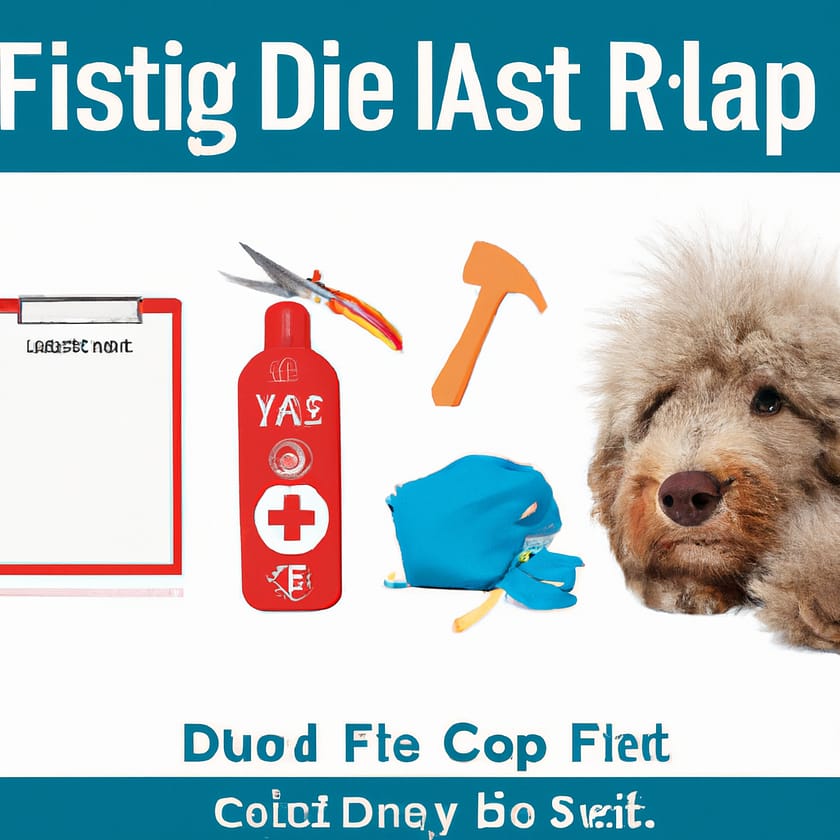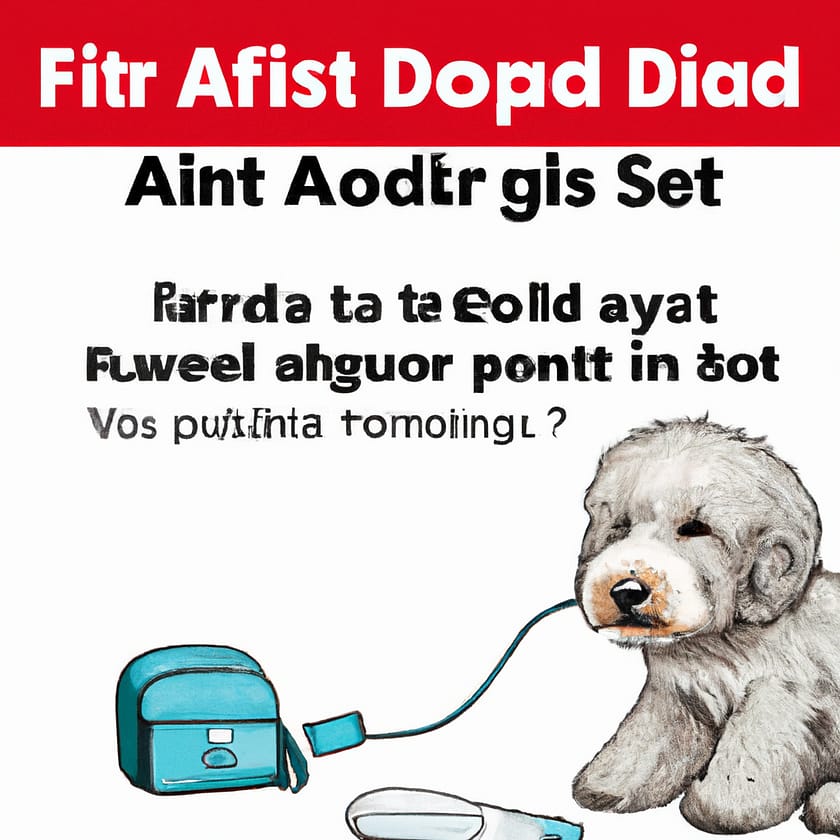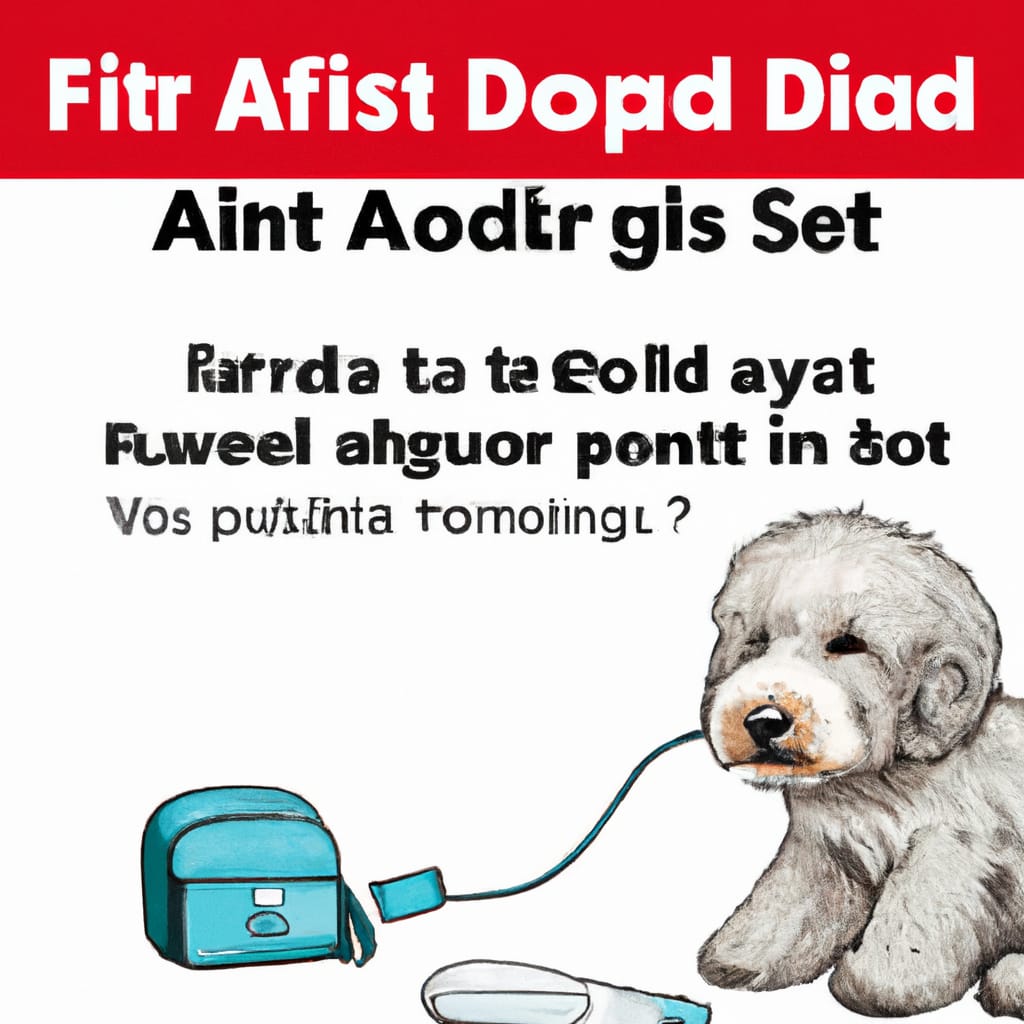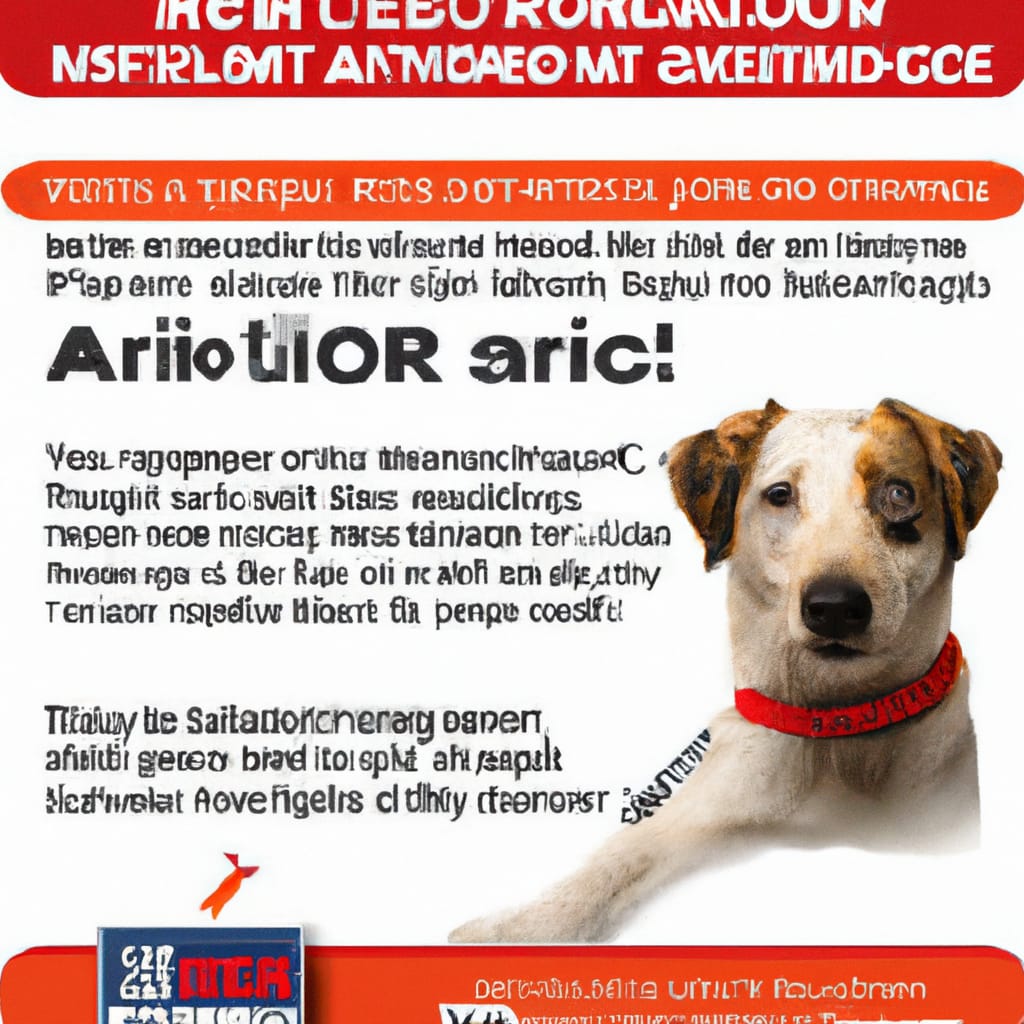Doodle Dog First Aid Kit: Essentials For Emergencies
Imagine you and your furry best friend, your adorable Doodle Dog, embarking on exciting adventures together. Whether it’s exploring new hiking trails or enjoying a day at the beach, accidents can happen. That’s why it’s important to be prepared with the Doodle Dog First Aid Kit: Essentials for Emergencies. This comprehensive kit includes everything you need to quickly and effectively address minor injuries and emergencies, providing you with peace of mind and keeping your beloved companion safe. From bandages and antiseptic wipes to a handy manual on pet first aid, this essential kit is a must-have for any pet owner. So go on, let your Doodle Dog’s tail wag with joy, knowing that you have their well-being covered.

Essential Supplies for a Doodle Dog First Aid Kit
When it comes to your beloved Doodle dog’s safety and well-being, having a well-stocked first aid kit is essential. Accidents and injuries can happen at any time, and being prepared can make all the difference in providing immediate care and potentially saving your furry friend’s life. Here are some must-have supplies for your Doodle dog’s first aid kit:
Bandages
Bandages play a crucial role in protecting your Doodle’s wounds and preventing further infection. Make sure to include a variety of bandage sizes, including self-adhesive wraps, gauze rolls, and adhesive bandages. These bandages should be sterile and hypoallergenic to avoid any adverse reactions.
Gauze pads
Gauze pads are another essential item for your Doodle dog’s first aid kit. They provide cushioning and promote proper wound healing. Make sure to include both sterile and non-sterile gauze pads in different sizes, as they can be used for cleaning wounds or as a protective layer before applying bandages.
Antibiotic ointment
To prevent infection in your Doodle’s wounds, having antibiotic ointment is crucial. Apply a small amount of the ointment to the cleaned wound before covering it with a bandage. This will help keep the wound clean and support the healing process.
Scissors
Quality scissors are an important tool to have in your Doodle dog’s first aid kit. They can be used to carefully trim hair around wounds before applying bandages. Make sure to choose scissors with blunt tips to minimize the risk of accidentally injuring your furry friend.
Tweezers
Tweezers are invaluable for removing splinters, thorns, or other foreign objects that may become lodged in your Doodle’s skin. Choose a pair with a pointed tip for precise and safe removal. Remember to disinfect the tweezers before and after each use to avoid introducing bacteria into the wound.
Thermometer
A reliable thermometer is essential for monitoring your Doodle’s body temperature. Fever can be a sign of an underlying illness or infection. Having a thermometer on hand will allow you to monitor your dog’s temperature and provide valuable information to your veterinarian.
Hydrogen peroxide
Hydrogen peroxide is a commonly used antiseptic for cleaning wounds and can also be used to induce vomiting in emergency situations, as advised by a veterinarian. However, it is important to note that hydrogen peroxide should only be used under the guidance of a veterinary professional, as improper use can be harmful.
Saline solution
Saline solution is a gentle and effective way to flush debris or clean wounds. It helps remove dirt and bacteria from the wound site, reducing the risk of infection. Make sure to have a sterile saline solution in your first aid kit, specifically formulated for use on animals.
Disposable gloves
Disposable gloves are essential for protecting both you and your Doodle dog during first aid treatments. They minimize the risk of contamination and the spread of germs. Remember to change gloves between treating different wounds or when handling different animals to prevent cross-contamination.
Tick removal tool
Ticks are a common concern, especially for Doodle dogs who love to explore the great outdoors. Having a tick removal tool on hand is crucial for safely and effectively removing ticks. These tools are designed to grasp the tick’s body without squeezing it, reducing the risk of leaving mouthparts behind.
Emergency Medications for a Doodle Dog First Aid Kit
In addition to the essential supplies for your Doodle dog’s first aid kit, certain medications can be lifesavers in emergency situations. These medications should only be used under the guidance of a veterinarian, but having them readily available in your kit can buy you valuable time before seeking professional help.
Antihistamines
Allergies can be a real concern for Doodle dogs, and an allergic reaction can quickly escalate into a life-threatening emergency. Antihistamines, such as diphenhydramine (Benadryl), can help control mild allergic reactions. Make sure to consult your veterinarian for the correct dosage based on your dog’s weight.
Activated charcoal
Activated charcoal is a valuable medication to have in your Doodle dog’s first aid kit in case of accidental ingestion of toxins or poisons. It can help absorb and neutralize harmful substances before they can be absorbed into your dog’s bloodstream. However, it is important to consult your veterinarian before administering activated charcoal.
Hydrocortisone cream
In the event of insect bites or stings, hydrocortisone cream can provide relief and help minimize the associated itching and inflammation. Make sure to consult your veterinarian for the appropriate strength of hydrocortisone cream for your Doodle dog.
Styptic powder
Accidental toenail trimming accidents happen, and when a nail is cut too short, it can result in bleeding. Styptic powder is an essential medication to have on hand to quickly stop bleeding from minor toenail injuries.
Benadryl
Benadryl is commonly used to alleviate mild allergic reactions in dogs. Whether it’s from an insect bite, an environmental allergen, or an adverse reaction to medication, Benadryl can help reduce itching, swelling, and other symptoms. However, always consult your veterinarian for the correct dosage.
Kaopectate
Kaopectate, an over-the-counter medication, can be used to provide relief in cases of mild gastrointestinal upset. It helps soothe the stomach and alleviate symptoms such as diarrhea and vomiting. However, it is important to contact your veterinarian to determine the appropriate dosage for your Doodle dog.
Emergency Care for Common Doodle Dog Injuries
Accidents can happen to even the most careful of Doodle dog owners. Knowing how to provide immediate care for common injuries can give your furry friend the best chance of a quick recovery. Here are some common injuries that Doodle dogs may encounter and how to address them:
Cuts and Scrapes
Cuts and scrapes are common injuries that can occur during playtime or outdoor adventures. To address a cut or scrape, start by gently cleaning the wound with saline solution. Apply gentle pressure to control any bleeding. If the wound is deep or doesn’t stop bleeding, seek veterinary care.
Bleeding Paw Pad
A bleeding paw pad can be particularly distressing for your Doodle dog. Start by cleaning the wound with saline solution and applying a sterile gauze pad to control the bleeding. Secure the pad in place with a bandage or self-adhesive wrap. If the bleeding persists or the wound is deep, contact your veterinarian.
Puncture Wounds
Puncture wounds are often caused by sharp objects, such as nails, or bites from other animals. These wounds can easily become infected due to their nature. Clean the wound thoroughly with saline solution and apply an antibiotic ointment. If the wound is deep or shows signs of infection, consult your veterinarian.
Sprained Limbs
Doodle dogs are active and agile, but sometimes accidents happen, resulting in sprained limbs. If you suspect a sprain, provide your Doodle dog with a quiet and calm environment. Apply a cold compress to reduce swelling and inflammation. Restrict their activity and consult your veterinarian for further advice.
Insect Bites or Stings
Insect bites or stings can cause discomfort and allergic reactions in Doodle dogs. Remove any visible stingers using tweezers and clean the area with saline solution. Apply a small amount of hydrocortisone cream to help relieve itching and reduce swelling. Monitor your dog for any signs of an allergic reaction.
Poisoning or Ingestion
In cases of poisoning or ingestion of toxic substances, it is vital to seek immediate veterinary care. Call your veterinarian or a pet poison control hotline for guidance on how to proceed. Do not induce vomiting unless specifically advised by a professional.
Heat Exhaustion or Heatstroke
Heat exhaustion or heatstroke can be life-threatening for Doodle dogs. If your dog shows signs of overheating, such as excessive panting, weakness, or collapse, move them to a cool and shaded area. Apply cool water to their body, particularly the belly and paws. Contact your veterinarian immediately for further instructions.
Allergic Reactions
Allergic reactions can range from mild to severe and can occur due to various triggers, such as food, medications, or insect bites. If your Doodle dog exhibits signs of an allergic reaction, such as itching, swelling, or difficulty breathing, contact your veterinarian immediately for guidance. Antihistamines may help control mild reactions, but severe reactions require immediate professional care.
Step-by-Step Guide for Administering First Aid to a Doodle Dog
In emergency situations, it’s crucial to remain calm and quickly assess the situation. Follow these steps to administer first aid to your Doodle dog:
Assess the Situation
Assess the situation and determine the severity of the emergency. Stay calm and prioritize your actions based on the urgency of the situation.
Ensure Your Safety and the Safety of the Dog
Before providing any first aid care, ensure your safety and the safety of your Doodle dog. If necessary, move the dog to a safe, stable location away from any potential dangers.
Perform Initial Assessment on the Dog
Conduct a thorough initial assessment of your Doodle dog’s vital signs, such as breathing, pulse, and level of responsiveness. Note any injuries, bleeding, or signs of distress.
Control Bleeding
If your Doodle dog is bleeding, apply gentle pressure to the wound with a clean cloth or gauze pad. Elevate the wounded area if possible. If bleeding persists or is severe, apply a tourniquet only as a last resort and seek immediate veterinary care.
Clean and Bandage Wounds
Clean visible wounds with saline solution or clean water. Apply antibiotic ointment to prevent infection. Use appropriate bandages, such as sterile gauze pads and self-adhesive wraps, to cover and secure the wounds. Monitor the bandages regularly for signs of infection or looseness.
Provide CPR or Rescue Breathing
In case of cardiac arrest, perform cardiopulmonary resuscitation (CPR) or rescue breathing as required until professional help is available. Learn these techniques from a qualified instructor to ensure proper execution.
Stabilize Fractures or Sprains
If you suspect your Doodle dog has a fracture or sprain, stabilize the affected limb using a splint or a piece of sturdy material. Restrict their movement, and seek immediate veterinary care.
Address Allergic Reactions
If your Doodle dog experiences an allergic reaction, administer antihistamines as directed by your veterinarian. Keep a close eye on your dog’s breathing and overall condition while waiting for professional advice.
Take the Dog to the Vet
Even if you have provided necessary first aid care, it is essential to take your Doodle dog to the vet for a thorough examination and further treatment. A professional evaluation ensures proper care and prevents potential complications.

Preventing Common Doodle Dog Emergencies
While it’s important to be prepared for emergencies with a well-stocked first aid kit, prevention is always better than cure. Here are some preventative measures to keep your Doodle dog safe and minimize the risks of emergencies:
Maintaining a Safe Environment
Create a safe living environment for your Doodle dog by removing hazards such as toxic plants, chemicals, and small objects that can be swallowed. Secure fences and gates, and provide a safe area for outdoor play.
Identifying Toxic Household Items
Familiarize yourself with common household items that can be toxic to dogs. Keep medications, cleaning supplies, and other harmful substances out of your Doodle dog’s reach. Store them securely in closed cabinets or designated areas.
Emergency Preparedness Training
Consider taking a pet first aid and CPR course to learn valuable lifesaving skills. Knowing how to respond in emergencies can greatly increase your Doodle dog’s chances of survival and recovery.
Ensuring Proper Exercise and Supervision
Doodle dogs are active and require regular exercise. Provide them with appropriate physical and mental stimulation to prevent boredom and destructive behavior. Supervise them during playtime and outdoor activities to prevent accidents and injuries.
Regular Veterinary Check-ups
Schedule regular check-ups with your veterinarian to ensure your Doodle dog’s overall health and detect any potential issues early on. Vaccinations, parasite prevention, and routine examinations can help prevent emergencies caused by preventable diseases.
Knowing When to Seek Professional Veterinary Care
While a well-stocked first aid kit and your initial care can address many Doodle dog emergencies, there are situations where professional veterinary care is necessary. Here are some signs that indicate the need for immediate professional attention:
Severe Bleeding
If your Doodle dog is experiencing severe bleeding that doesn’t subside with pressure, immediate veterinary care is essential. Severe bleeding can be life-threatening and requires professional intervention.
Difficulty Breathing
Breathing difficulties, such as rapid or labored breathing, wheezing, or choking, require immediate veterinary attention. Difficulty breathing can indicate underlying health issues that need prompt diagnosis and treatment.
Unconsciousness
If your Doodle dog is unresponsive or unconscious, immediately seek veterinary care. Unconsciousness can be a sign of a serious medical condition or trauma that requires professional evaluation and care.
Broken Bones
Suspected broken bones or fractures should be addressed by a veterinarian. Attempting to stabilize fractures without professional guidance can lead to further injury or complications.
Seizures
Seizures are abnormal neurological events that require veterinary attention. Monitor the duration and frequency of seizures and seek immediate veterinary care to determine the underlying cause and appropriate treatment.
Signs of Allergic Reaction
Mild allergic reactions can often be managed with antihistamines, but severe reactions require immediate veterinary attention. Signs of a severe allergic reaction include facial swelling, difficulty breathing, or collapse.
Vomiting and Diarrhea
Persistent vomiting and diarrhea can quickly lead to dehydration and electrolyte imbalances. If your Doodle dog is experiencing prolonged episodes or showing signs of distress, consult your veterinarian for guidance.
Ingestion of Toxic Substances
If your Doodle dog ingests a potentially toxic substance, contact your veterinarian or a pet poison control hotline immediately. Prompt action is critical to limit the effects of the toxin on your dog’s health.
Creating a Customized Doodle Dog First Aid Kit
Having a well-organized and customized first aid kit for your Doodle dog ensures that you are prepared for emergencies. Here are some steps to create a personalized kit:
Selecting the Right Bag or Container
Choose a sturdy bag or container that is easily accessible and can hold all the necessary supplies. Consider a waterproof and durable option to protect the contents from moisture and damage.
Including Contact Information for Veterinarian and Emergency Clinic
Attach a tag or label with your veterinarian’s contact information and after-hours emergency clinic details to the outside of the first aid kit. This will provide quick access to essential information, especially during stressful situations.
Checking and Restocking Supplies Regularly
Regularly check your Doodle dog’s first aid kit to ensure that all supplies are in good condition and not expired. Replace any used or expired items promptly, and restock any materials that are running low.
Conclusion
By being prepared for emergencies and having a well-stocked first aid kit, you can provide the immediate care your Doodle dog may need in critical situations. Remember to take first aid training to familiarize yourself with the necessary techniques and procedures. Additionally, knowing your Doodle dog’s health history and seeking regular veterinary check-ups are crucial steps in ensuring their overall well-being. With proper preparedness and preventative measures, you can keep your Doodle dog safe and give them the best chance at a healthy and happy life.













